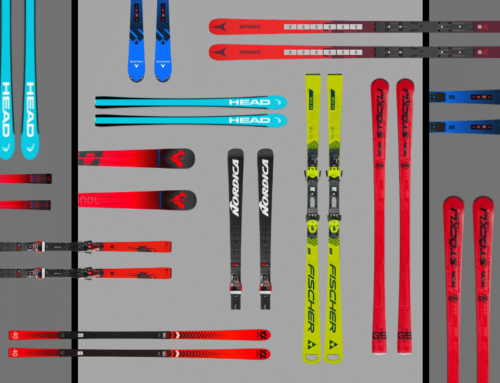Ski Racing’s Gary Black Voted into USSS Hall of Fame
Gary Black, Lindsey Vonn Vancouver Olympics Photo: John Meyer
As the USSS Hall of Fame Class of 2022 is announced, one inductee has special significance to this publication. It is Gary Black Jr., who purchased Ski Racing in 1984 and built it into what Sports Illustrated described as “The Bible” of the sport. Other than 2003-2006, when he sold, then repurchased Ski Racing, Black was at the helm of the publication until his death in 2017. Along the way, he elevated ski racing globally, through reporting and storytelling unprecedented and still unparalleled in the sport.
A spot in the Hall of Fame highlights not only a lifetime of accomplishments but contributions that have an enduring positive impact on the sport. In this regard, Black hit the bullseye.
Click on images to enlarge


At his heart, Black was a newspaper man, an outdoorsman and a skier. Black was born into the newspaper business, his grandfather having bought the Baltimore Sun in 1915. Black built his career in journalism at The Sun. He worked up from the crime beat to sales to ultimately creating their marketing department. Alongside this career was a parallel pursuit of skiing with stints on the National Ski Patrol at several resorts and membership in the Ski Club Arlberg. When he bought Ski Racing in 1984, it was the outlet for his vocation and his passions.

BUILDING “THE BIBLE OF THE SPORT”
The title conferred on Ski Racing by Sports Illustrated in 1990 carried meaning and responsibility. Like the Bible, Ski Racing served as both a chronicler of the sport’s history and a lens into the future. It guided the sport’s evolution through debate and discussion, its pages capturing the voices and stories from across the country and across the pond.
Black moved Ski Racing from Poultney, VT, north to Waitsfield, where he assembled a classic newsroom. It was anchored by experienced writers and editors, including Tim Etchells, Hank McKee and Paul Robbins. As Etchells notes, “There was nothing comparable to it in any other Olympic sport. We had freelancers and photographers all over the place, and they were good—and they weren’t doing it for free.”
Black also brought in young, energetic and often totally inexperienced writers who shared the common love of ski racing. “That was the model really,” said Etchells, “to get people who were really emotionally invested in the sport, and see if you couldn’t harness their enthusiasm in a way to produce a publication that spoke to them and their peers.” The mix of established pros supporting emerging talent lent Ski Racing legitimacy and vitality. It also built an ecosystem to sustain the sport’s future.
SKI RACING’S ROOKIE RECRUITS
Steve Porino got his start by writing one article for Ski Racing. From there he jumped right into a full-time job at the Waitsfield office. There, he experienced Ski Racing’s legendary low pay and long hours, as well as mentorship and a graduate level journalism education.
When Porino auditioned for a job with NBC, Black wholeheartedly supported him. Eventually, Porino became ski racing’s most recognizable TV personality. Other ski writers and editors who came through the crucible of Ski Racing include: Andy Bigford, future editor of Snow Country and SKI; Perkins Miller, future editor of Mountain Sports and Living and Skiing; Nate Vinton, acclaimed sports writer/reporter and author of The Fall Line: How American Ski Racers Conquered a Sport on the Edge; and many, many others who used Ski Racing as a springboard to careers that further championed the sport. “He was not there to hold you up,” says Porino. “Rather, he was there to celebrate skiing and ski racing and to move people along in their careers. He gave a lot of people wings.”
Black strongly supported women moving up through the ranks of the organization. Claire Abbe Brown came to Ski Racing straight out of DU, where she competed on two NCAA Championship winning teams. In ten years she wore every hat, including five as publisher. She went from being “over” ski racing to being one of the sport’s most ardent historians. “I got that all from being around Gary and seeing his passion, especially for storytelling and history,” says Brown. She went on to produce the American Downhiller documentary, and most recently Picabo, about Picabo Street. In a way, American Downhiller, which showcased the rise of Americans in a European dominated sport, represented what Black had done with Ski Racing— planted an American flag firmly in European soil to stake out our own territory.

SPANNING THE GLOBE
Patrick Lang’s father Serge co-founded the World Cup, and he started covering the circuit in 1969. He had a deep appreciation for Black’s commitment. The elder Lang started the Association International de Ski Journalists (AISJ), which welcomed Black and Ski Racing. While not a source for timely results, Europeans looked to Ski Racing for in-depth stories on competitors from all nations. “It’s great to have him in the US. Ski Hall of Fame,” says Lang. He calls Black “one of the great defenders of the World Cup in North America.” To this day, Lang notes, even The Denver Post has never covered Kitzbühel, ski racing’s biggest spectacle.
Ski Racing not only regularly covered the Word Cup, but sent a fleet of reporters and photographers to major events. At the Olympics and World Championships, Ski Racing set up camp, recording multiple competition and color stories each day. They also stayed on top of all the latest industry news and trends by publishing Ski Trade News, as well as a daily paper from a trailer inside the annual SIA convention in Las Vegas.
SPANNING THE AGES AND THE ISSUES
On the home front, Hank McKee “melted the letters off his keyboard,” as Porino recalls, writing up local race results and junior events. Because of those efforts, generations of kids could read their names in print in Ski Racing. It planted the seed for kids to dream of someday becoming Ski Racing’s Junior Alpine Skier of the Year. Recipients of the coveted award, an annual tradition since 1975, later claimed a goldmine of medals, victories and titles. For athletes who did make it to the World Cup, Black was also the unofficial welcoming committee. That came in grand acts of generosity, like hosting team dinners in Europe. It also came in quieter gestures, like inviting rookies to dinner at a favorite restaurant to offer encouragement. These relationships led to trust, understanding, and always great stories.
Beyond race reporting, the pages of Ski Racing guided the sport’s evolution, by encouraging robust exploration, discussion and debate of issues, featuring many voices. Black himself was among the most outspoken. He served on the FIS PR and Media Committee and World Cup Committee, and also on the US Ski Team board. Nonetheless, he was unafraid to take on issues with the FIS, the World Cup and the National Team. His Black Diamonds editorial column offered a critical voice in an accessible forum. This was unique and powerful in the ski racing community. “That was his way of asking the hard questions that no one would really do,” says Brown. If it was a hot button issue, it found sunlight in the pages of Ski Racing.


SKI RACING MEDIA AND THE DIGITAL ERA
Black saw Ski Racing through the transition to the digital era, first moving from print to a digital magazine, and then to entirely website-based content. The transition was fortuitous. The company had already shifted to a remote office structure in 1995, when Black’s family moved to Sun Valley. It also worked for a company that operated with minimal resources. “We used to joke that we were pioneers in the digital space,” says Brown. “Really, we were just doing it to lose less money.” At best, Ski Racing was a break-even scenario, though Black’s commitment to complete coverage made it appear otherwise. “We always operated above our means,” recalls Porino.
At his heart, Black simply loved ski racing, and his impact was felt at all levels of the sport. Paul Fremont-Smith first knew Black through their work with eastern ski associations, Black with VARA, Fremont-Smith with MARA. Their dedication to junior racing continued in Sun Valley on projects supporting the Sun Valley Ski Education Foundation. “Gary always had an eye out for the youth and development programs,” says Fremont-Smith. “Anyone who can support all the way through, from development ski programs to the A Team, has made a life contribution to ski racing.”
Gary’s wife Heather says he would be humbled and honored to join the ranks in the Hall of Fame. He’d even be a bit surprised. “After all, he was just indulging in his passion for the sport of skiing. It wasn’t work; it was play!” says Heather. “He wanted to make a difference for the betterment and growth of the sport. He, in fact, did work hard at it. Whether and when he accomplished his goals or not, his efforts have not gone unrecognized. I know that would have meant the world to him.”
The Class of 2022 will be officially inducted into the Hall of Fame in Big Sky Montana on March 25, 2023.
Enjoy the photo gallery and remember to click on an image to enlarge






























